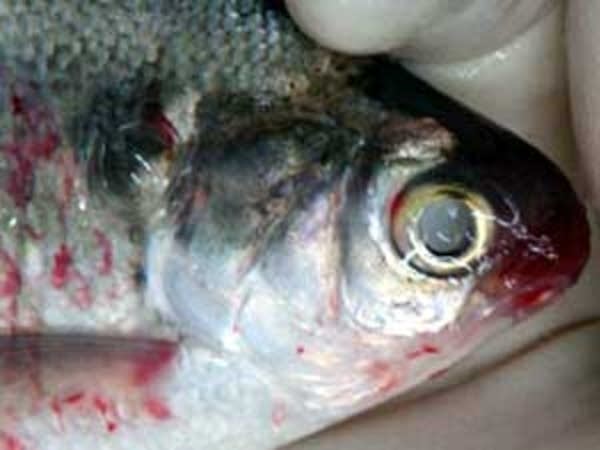Group warns of approaching fish disease
Go Deeper.
Create an account or log in to save stories.
Like this?
Thanks for liking this story! We have added it to a list of your favorite stories.

It's a disease known to infect salt water fish, but no one really knows how viral hemorrhagic septicemia came to be a highly contagious and often fatal disease for fresh water fish in the Great Lakes.
It's blamed for huge fish kills last summer in Lake Erie, where killed large numbers of fresh water drum, yellow perch, and round gobies.

"But it was the fresh water drum die off that gathered the most attention because we had dead fish floating everywhere, and actually forming wind rows on the beaches," says Fred Snyder, an extension specialist with Ohio Sea Grant.
The virus known as VHS was first identified in the lakes two years ago, but it might have been around much longer. It's not always obvious. VHS can cause a distended abdomen, or sometimes red patches on a fish's head or near its gills. The real damage is done to internal organs.
Turn Up Your Support
MPR News helps you turn down the noise and build shared understanding. Turn up your support for this public resource and keep trusted journalism accessible to all.
What's troubling, Snyder says, is how many kinds of fish are susceptible.
"Can you imagine the St. Louis Bay without a fishery? Can you imagine our region's lakes without a fishery, and the economic impact of all of that?"
"It has been found in 37 species,"says Snyder. That does not mean that all of them have had die offs. It simply means that when they take kidney tissue samples they do find the virus."
The virus isn't believed harmful to humans. Beyond the "ick" factor on the beach, the real trouble could be to businesses that deal with live fish.
"The big concern right now is that the virus will get into fish farms - the aquaculture facilities - and potentially wipe out a chunk of the nation's aquaculture capability," Snyder says.
Already the federal government has clamped tight restrictions on anybody moving live fish to or from Great Lakes states. That could be a problem for the bait industry.
And, while it's unclear how the disease has spread, some conservationists say a likely culprit is ship ballast water.
At a press conference in Duluth's Great Lakes Aquarium, the Izaak Walton League has called for new ballast water treatment rules to take effect before the first "lakers" sail in March. Gary Glass is a former researcher at the Environmental Protection Agency's fresh water laboratory in Duluth.

"As it turns out, the EPA lab did some research in the early '70s, to deal with disinfection of diseases, and how you would remediate any negative impact from that," Glass says. "The chlorination process, which documents over 100 years of history in dealing with disinfection of diseases, is one of the approaches that can be used to treat for this disease in any kind of ballast water that might carry it."
The cost, he says, would be negligible, and he says the chlorine can be neutralized before the ballast water is released again into the lakes.
But the shipping industry may not move on the idea quickly. The U.S. Coast Guard has spent several years drawing up ballast water rules. A Coast Guard official couldn't say what procedures might be in the future rules, but he says there are some problems with chlorination.
"I think it's been found that chlorine is very effective in killing a variety of critters, but there is some concern with the use of chlorine in ballast water tanks," says Bivan Patnaik with the Coast Guard in Washington D.C. "That is the chlorine could possibly corrode those tanks."

Still the Izaak Walton League has grown impatient. Dave Zentner says the studies have gone on too long. He says it's better now to adopt a good solution than to keep waiting for a perfect solution. Zentner says there's too much at stake.
"Can you imagine the St. Louis Bay without a fishery?" Zentner asks. "Can you imagine our region's lakes without a fishery, and the economic impact of all of that?"
The Izaak Walton League is pushing its idea on both state and federal levels. They hope to get something passed the State Legislature this session, but they're also talking on the federal level with U.S. Rep. James Oberstar, who chairs the House Transportation Committee.
The club kicks off their campaign with a public meeting in Duluth Thursday night.
Dear reader,
Political debates with family or friends can get heated. But what if there was a way to handle them better?
You can learn how to have civil political conversations with our new e-book!
Download our free e-book, Talking Sense: Have Hard Political Conversations, Better, and learn how to talk without the tension.





